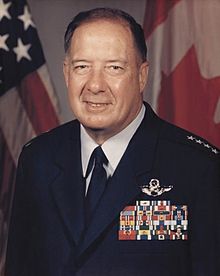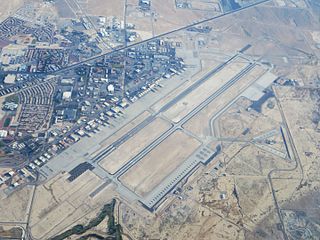
Nellis Air Force Base is a United States Air Force installation in southern Nevada. Nellis hosts air combat exercises such as Exercise Red Flag and close air support exercises such as Green Flag-West flown in "Military Operations Area (MOA) airspace", associated with the nearby Nevada Test and Training Range (NTTR). The base also has the Combined Air and Space Operations Center-Nellis.

John Phillip Jumper is a retired United States Air Force (USAF) general, who served as 17th Chief of Staff of the United States Air Force from September 6, 2001 to September 2, 2005. He retired from the USAF on November 1, 2005. Jumper was succeeded as Chief of Staff by General T. Michael Moseley.

Tactical Air Command (TAC) is an inactive United States Air Force organization. It was a Major Command of the United States Air Force, established on 21 March 1946 and headquartered at Langley Air Force Base, Virginia. It was inactivated on 1 June 1992 and its personnel and equipment absorbed by Air Combat Command (ACC).

Major General Robertus Carolus Nicolaa Remkes is Director, Strategy, Policy and Assessments, U.S. European Command, Stuttgart-Vaihingen, Germany. As Director of Strategy, Plans and Policy, he is responsible for formulation and staff direction of the execution of basic military and political policy, as well as planning for command activities involving relations with other U.S. Unified Commands, allied military and international military organizations and subordinate commands. He also serves as Director of Capabilities and Assessments. In this capacity he is responsible for the development of force structure requirements; conducting studies, analyses and assessments; and for evaluating military forces, plans, programs and strategies.

Joseph William Ashy, is a retired United States Air Force (USAF) general who was commander in chief of North American Aerospace Defense Command and United States Space Command, and commander of Air Force Space Command, headquartered at Peterson Air Force Base, Colorado. As commander of NORAD, General Ashy was responsible for the air sovereignty of the United States and Canada, as well as for providing tactical warning and attack assessment. As USCINCSPACE, he commanded the unified command responsible for directing space control and support operations including theater missile defense. As COMAFSPC, he directed satellite control, warning, space launch and ballistic missile operations missions through a worldwide network of support facilities and bases.
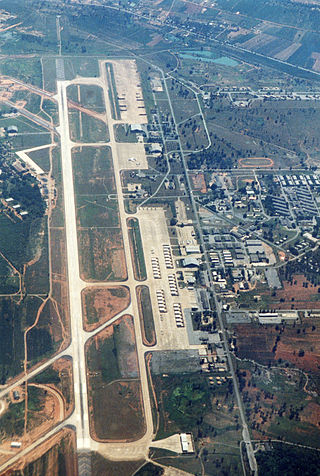
Korat Royal Thai Air Force Base is a base of the Royal Thai Air Force (RTAF) in northeast Thailand, approximately 200 km (125 mi) northeast of Bangkok and about 4 km (2.5 mi) south of the centre of the city of Nakhon Ratchasima in the Nakhon Ratchasima Province, the largest province in Thailand.

George Air Force Base was a United States Air Force base located within the city limits, 8 miles northwest, of central Victorville, California, about 75 miles northeast of Los Angeles, California.

Takhli Royal Thai Air Force Base is a Royal Thai Air Force (RTAF) facility in central Thailand, approximately 144 miles (240 km) northwest of Bangkok in Takhli District, Nakhon Sawan Province.

Ralph Edward "Ed" Eberhart is a retired four-star general in the United States Air Force (USAF). He served as the commander of North American Aerospace Defense Command (NORAD) and United States Northern Command, Peterson Air Force Base, Colorado. He was in charge of NORAD during the September 11 attacks in 2001.

Victor Eugene "Gene" Renuart Jr. is a retired United States Air Force four-star general. His last military assignment was as the commander of United States Northern Command and North American Aerospace Defense Command from March 23, 2007, to May 19, 2010. Prior to that, he served as director of strategic plans and policy, the Joint Staff. Renuart retired from the Air Force on July 1, 2010, after over 39 years of service.

The 37th Training Wing is a unit of the United States Air Force assigned to the 2nd Air Force and the Air Education and Training Command. As the host unit to Lackland Air Force Base, Joint Base San Antonio, Texas, the 37th TRW is the predominant unit on the installation and is the largest training wing in the USAF. Known as the "Gateway to the Air Force", the 37th Training Wing's replaced the Lackland Training Center as the single basic military training for the USAF.

Carrol Howard "Howie" Chandler, is a retired United States Air Force four-star general. He last served as the 35th Vice Chief of Staff of the Air Force from August 27, 2009, to January 14, 2011. He previously served as commander of Pacific Air Forces from November 2007 to August 20, 2009, and deputy chief of staff for operations, plans and requirements from October 23, 2005, to November 29, 2007. As vice chief, he presided over the Air Staff and served as a member of the Joint Chiefs of Staff Requirements Oversight Council and Deputy Advisory Working Group. He assisted the chief of staff with organizing, training, and equipping of 680,000 active-duty, Guard, Reserve and civilian forces serving in the United States and overseas. He retired from the Air Force by March 1, 2011. In 2012 he joined Pratt & Whitney Military Engines as vice president for military business development and international programs.

The 388th Fighter Wing (388FW) is a United States Air Force unit assigned to the Air Combat Command Fifteenth Air Force. The unit is stationed at Hill Air Force Base, Utah.

Gary Lewis North is a retired United States Air Force four-star general who served as commander of Pacific Air Forces and executive director of Pacific Air Combat Operations Staff at Hickam Air Force Base, Hawaii, from August 19, 2009, to August 9, 2012. Pacific Air Forces is responsible for Air Force activities spread over half the globe in a command that supports 45,000 airmen serving principally in Hawaii, Alaska, Guam, Korea and Japan.
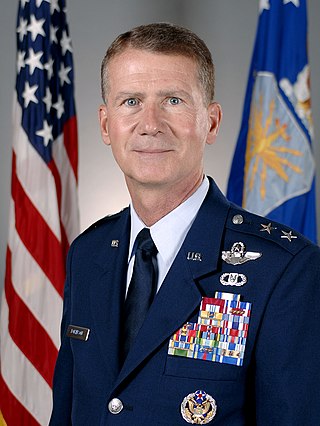
David A. Robinson is a retired major general in the United States Air Force who served as mobilization assistant to the Chief of the Air Force Reserve, Headquarters United States Air Force, Washington, D.C.

The United States Air Force's 66th Weapons Squadron is a United States Air Force Weapons School Fairchild Republic A-10 Thunderbolt II instructional flying unit, at Nellis Air Force Base, Nevada.

James Robert Brown was a lieutenant general in the United States Air Force who served as vice commander of Tactical Air Command, with headquarters at Langley Air Force Base, Virginia. The command comprises more than 118,000 military and civilian personnel, stationed at 18 major Tactical Air Command installations and other units in the United States, Panama, Okinawa and Iceland. Tactical Air Command was the operational combat organization for 74,000 Air National Guard and Air Force Reserve personnel throughout the United States.

Joseph Lauren Lengyel is a retired United States Air Force four-star general who last served as the 28th chief of the National Guard Bureau from August 2016 to August 2020. As chief, he was responsible for ensuring that nearly 460,000 Army National Guard and Air National Guard personnel are accessible, capable and ready to protect the homeland and to provide combat capabilities to the United States Army and the United States Air Force. Lengyel is a command pilot with more than 3,000 flying hours primarily in the F-16.

Tod Daniel Wolters is a retired United States Air Force four-star general who last served as the commander of U.S. European Command and concurrently as NATO's Supreme Allied Commander Europe (SACEUR). He previously served as the commander of U.S. Air Forces in Europe and U.S. Air Forces Africa. He assumed his capstone assignment at the European Command in Germany on May 2, 2019 and at the Allied Command in Belgium on May 3, 2019.
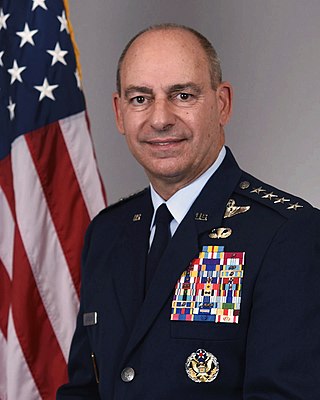
Jeffrey Lee Harrigian is a retired United States Air Force general who last served as the commander of United States Air Forces in Europe and Air Forces Africa from May 2020 to June 2022. He concurrently served as the commander of Allied Air Command and director of the Joint Air Power Competence Center. He previously served as deputy commander and as commander of United States Air Forces Central Command. Raised in Sparks, Nevada, he graduated from the United States Air Force Academy with a degree in International Affairs and was commissioned in 1985. He assumed his capstone assignment on May 1, 2019.
